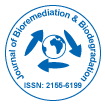Research Article
Seeking Potential Anomalous Levels of Exposure to PCDD/Fs and PCBs through Sewage Sludge Characterization
| Rada EC1*, Schiavon M1,2, Ragazzi M1 | |
| 1Department of Civil Environmental and Mechanical Engineering, Via Mesiano, University of Trento, Italy | |
| 2Fondazione Trentina per la Ricerca sui Tumori, Corso III Novembre 162, I-38122–Trento, Italy | |
| Corresponding Author : | Rada EC Department of Civil Environmental and Mechanical Engineering University of Trento, Via Mesiano 77 I-38123 Trento, Italy E-mail: elena.rada@unitn.it |
| Received September 02, 2013; Accepted October 21, 2013; Published October 27, 2013 | |
| Citation: Rada EC, Schiavon M, Ragazzi M (2013) Seeking Potential Anomalous Levels of Exposure to PCDD/Fs and Pcbs through Sewage Sludge Characterization. J Bioremed Biodeg 4:210. doi: 10.4172/2155-6199.1000210 | |
| Copyright: © 2013 Rada EC, et al. This is an open-a ccess article distributed under the terms of the Creative Commons Attribution License, which permits unrestricted use, distribution, and reproduction in any medium, provided the original author and source are credited. | |
Related article at  |
|
Abstract
An approach to detect anomalies in the exposure to Persistent Organic Pollutants (POPs) throughout the food chain is presented. The proposed method is useful also for preventing soil contamination by POPs that would require a remediation intervention. A steel making plant and its surrounding area were selected as a case-study. To investigate the possible effects of the plant on the settled population, sewage sludge samples from four wastewater treatment plants (WWTPs) were taken: one of these was chosen as reference for the population exposed to the emissions of the mill; the remaining three plants were chosen to provide background information about the POP content in sludge. No clear anomalies in dioxins (PCDD/Fs) were detected for the potentially exposed population. In terms of Polychlorinated Biphenyls (PCBs), the steel plant-influenced WWTP showed a total concentration between 2.7 and 4.8-time higher than the other plants; in terms of equivalent toxicity, only slightly higher concentrations were found for the steel plant-influenced WWTP. Therefore, if considering acceptable the daily intake from the diet of the unexposed population, the absence of a dioxin and dioxin-like emergency in the area of the mill is demonstrated. This method represents an innovative and technically simple tool to assess situations of permanent exposure to POP levels that are higher than the background.
